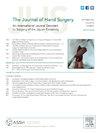Epidemiology of Congenital Upper-Limb Anomalies in Southern Taiwan Based on the Updated Oberg, Manske, and Tonkin Classification: A Series of 1,335 Anomalies in 1,188 Patients
IF 2.1
2区 医学
Q2 ORTHOPEDICS
引用次数: 0
Abstract
Purpose
This study aimed to investigate the relative frequency of congenital upper-limb anomalies (CULAs) in southern Taiwan using the 2020-updated the Oberg, Manske, and Tonkin (OMT) classification system and evaluate the practicality of the new classification system.
Methods
We retrospectively reviewed patients with CULAs from 1987 to 2021 at a referral center in southern Taiwan. All patients were analyzed based on medical records, photographs, and radiographs, and the anomalies were classified according to the 2020 OMT classification system.
Results
A total of 1,188 patients with 1,335 CULAs were retrospectively reviewed. The results demonstrated that the most common type of CULA was malformations (1,092 cases), followed by dysplasias (144 cases), syndromes (51 cases), and deformations (48 cases). Among the malformations, radial polydactyly was the most common anomaly (732 cases), followed by simple syndactyly (66 cases). Among the dysplasias, camptodactyly was the most common anomaly (52 cases), followed by thumb-in-palm deformity (45 cases) and vascular tumors (17 cases). In the deformations, constriction ring sequence accounted for all cases. Poland syndrome (21 cases) occurred most often in the category of syndromes.
Conclusions
The results of this study show that radial polydactyly (732 cases, 55%) is the most common CULA in southern Taiwan, followed by simple syndactyly (66 cases, 5%) and then camptodactyly (52 cases, 4%).
Clinical relevance
The OMT classification system is reasonably practical for precise classification of CULAs and enables easy comparison of studies over different time periods. However, continually updating the OMT classification system is required to better categorize the highly variable presentations of CULAs.
基于更新Oberg, Manske, Tonkin分类的台湾南部先天性上肢异常流行病学:1188例1,335例异常。
目的:本研究旨在利用2020年更新的Oberg, Manske, and Tonkin (OMT)分类系统,调查台湾南部先天性上肢异常(CULAs)的相对频率,并评估新分类系统的实用性。方法:我们回顾性分析1987年至2021年在台湾南部一家转诊中心的CULAs患者。所有患者均根据病历、照片和x线片进行分析,并根据2020年OMT分类系统对异常进行分类。结果:回顾性分析了1188例1335例cula患者。结果显示,CULA最常见的类型是畸形(1092例),其次是发育不良(144例)、综合征(51例)和畸形(48例)。畸形中以桡侧多指畸形最多见(732例),其次为单纯性并指畸形(66例)。在发育不良中,以喜足畸形最多见(52例),其次为掌内拇指畸形(45例)和血管性肿瘤(17例)。在变形中,收缩环序列占所有病例。波兰综合征(21例)在综合征类别中最常见。结论:本研究结果显示,台湾南部地区最常见的CULA为桡侧多指畸形(732例,55%),其次为单纯并指畸形(66例,5%),其次为喜足畸形(52例,4%)。临床相关性:OMT分类系统对于cula的精确分类是相当实用的,并且可以方便地比较不同时期的研究。然而,需要不断更新OMT分类系统,以便更好地对cula的高度变化的表现进行分类。
本文章由计算机程序翻译,如有差异,请以英文原文为准。
求助全文
约1分钟内获得全文
求助全文
来源期刊
CiteScore
3.20
自引率
10.50%
发文量
402
审稿时长
12 weeks
期刊介绍:
The Journal of Hand Surgery publishes original, peer-reviewed articles related to the pathophysiology, diagnosis, and treatment of diseases and conditions of the upper extremity; these include both clinical and basic science studies, along with case reports. Special features include Review Articles (including Current Concepts and The Hand Surgery Landscape), Reviews of Books and Media, and Letters to the Editor.

 求助内容:
求助内容: 应助结果提醒方式:
应助结果提醒方式:


